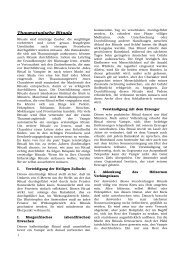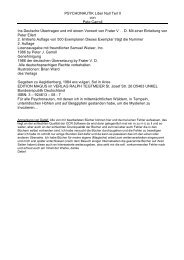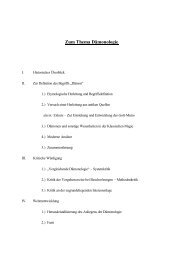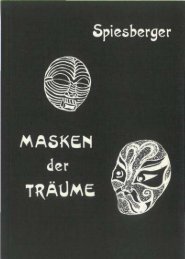CHAPTER 2 CHAPTER 3 CHAPTER 1 CHAPTER 2 CHAPTER 3 ...
CHAPTER 2 CHAPTER 3 CHAPTER 1 CHAPTER 2 CHAPTER 3 ...
CHAPTER 2 CHAPTER 3 CHAPTER 1 CHAPTER 2 CHAPTER 3 ...
You also want an ePaper? Increase the reach of your titles
YUMPU automatically turns print PDFs into web optimized ePapers that Google loves.
<strong>CHAPTER</strong> 1 67<br />
depths of degradation to which he had sunk he arose with skull of ape; he walked upright on two legs; he<br />
became the prey of beasts instead of hunter. He made for himself habitations in trees and prowled by night<br />
seeking food. Deep, deep was his ignorance. Little more than beast was he indeed, with almost no spark of<br />
divinity left to him."<br />
The abomination was so vast that forms were fusing together into monsters having no purpose but<br />
self-destruction. Men and animals were growing interchangeable of spirit and structure. Man was beastly and<br />
beast was manlike. Spirit knew not itself, whether it were divine or whether it were experiment of Thought<br />
Incarnate. They had so interchanged that they could no longer be accepted by the Host on the Sirian planets as<br />
divine. All physical forms had to be cleansed. "Pure beast must be preserved as beast; pure angel-man must be<br />
preserved as angel-man. Therefore, a vast catastrophe was decided upon. Ice from polar seas was melted and<br />
released upon continents of monsters." The Elder Brother tells us: "No longer could life make physical<br />
vehicles by thought. Forms existing in purity were preserved. Monsters and anomalies were destroyed. No<br />
longer could they propagate. Pure species were saved and pronounced sterile unto all but themselves."<br />
By being pronounced "sterile unto all but themselves" means, of course, that they could only breed their own<br />
species and kind. That is why today man can only mate with other human beings. No longer can the half-man<br />
and half-animal creatures be produced. The only reference to them today is in ancient legends.<br />
The griffin has already been mentioned. It was the Gryps or Gryphus of Greek mythology. A monster with the<br />
head and wings of an eagle, the body of a lion, and sometimes the tail of a serpent. The most familiar and least<br />
complicated of the composite beings known as bird-man creatures are the medieval angels and demons, the<br />
fairies, the Greek Keres (represented as tiny human figures with butterfly wings).<br />
Many representations of Egyptian gods embody combinations of human and bird anatomy, for they say the<br />
gods were first birds and animals and only gradually evolved into men. Perhaps the most complicated and<br />
fearsome of these creatures is the Gorgon, which had serpent hair, the hideous face of a woman, the wings of<br />
a bird, and the body of a lioness with bronze claws. The most frightful of these was Medusa.<br />
The important feature of the Hindu Garuda bird is that it is one of the few combinations with the head of a<br />
bird. Other features vary considerably with locale (it is known in India, Indochina, China, Japan, and many<br />
other places).<br />
The Egyptian soul was sometimes depicted as a bird with a human head, as was also the Greek Harpy, which<br />
befouled everything it touched. The Sirens were similar in form, but had beautiful voices and lured men to<br />
their downfall. The Welsh Washer of the Ford is a spectral female in black with the wings of a bat. The Furies<br />
are another of these combinations.<br />
The Sphinx is a combination of man-bird-beast, that is, the head and chest of a man, wings of a bird, and the<br />
body of an animal. In Egypt sphinxes were always male, and had the body of a lion. The Greek female sphinx<br />
also had a lioness' body. The Babylonian shedu, the Hebrew shedim, and the Sumerian clad were similar to<br />
the Egyptian, and male. They had the bodies of bulls, neatly curled beards, and often wore hats. The female<br />
counter-part of the sedu was called lamina or lamassu and could fly. The Syrian female sphinx had wings and<br />
resembled the Egyptian.<br />
The sacred bull-men of Babylonia are extraordinary beings. They were first seen only on rock drawings, and<br />
small seals, but later they were used for imposing statuary like the winged bull with a human face from<br />
Sargon's palace in Khorsabad.<br />
The so-called "dragon" of Babylon was found on the walls of the Ishtar Gate. It was called the "mighty<br />
snake". It had the head and scales of a snake, but the body of an unidentified monster. This creature had lion's<br />
paws and eagle's claws.






